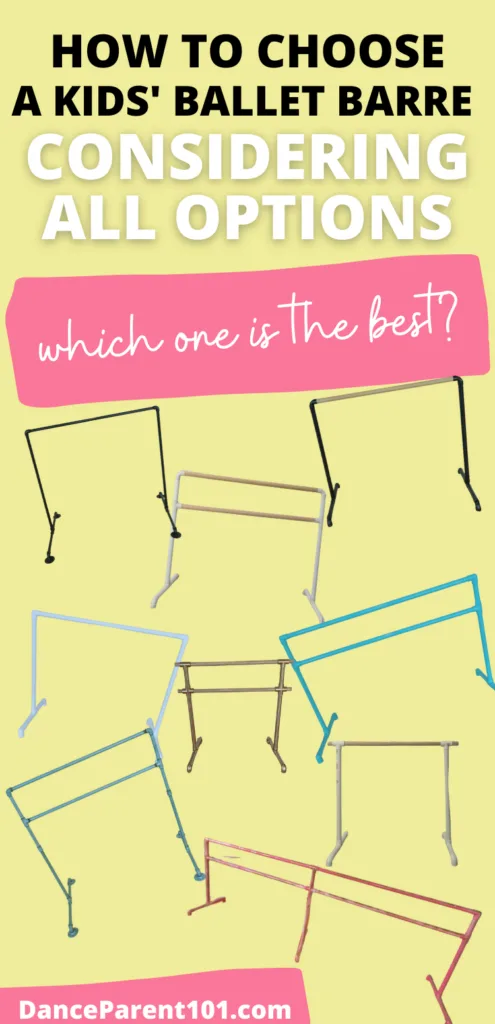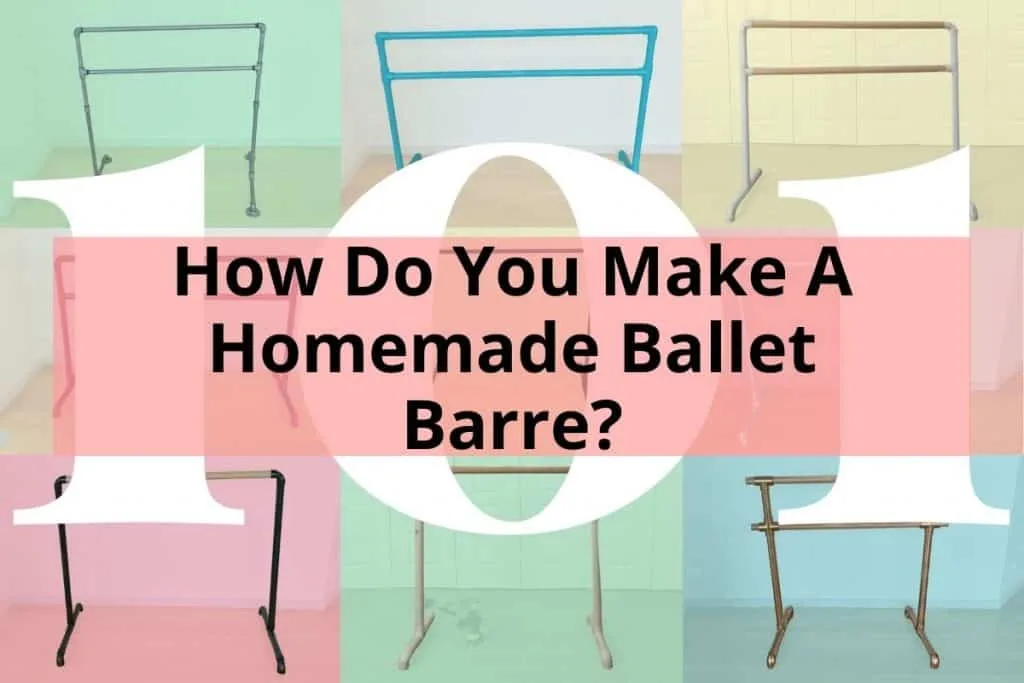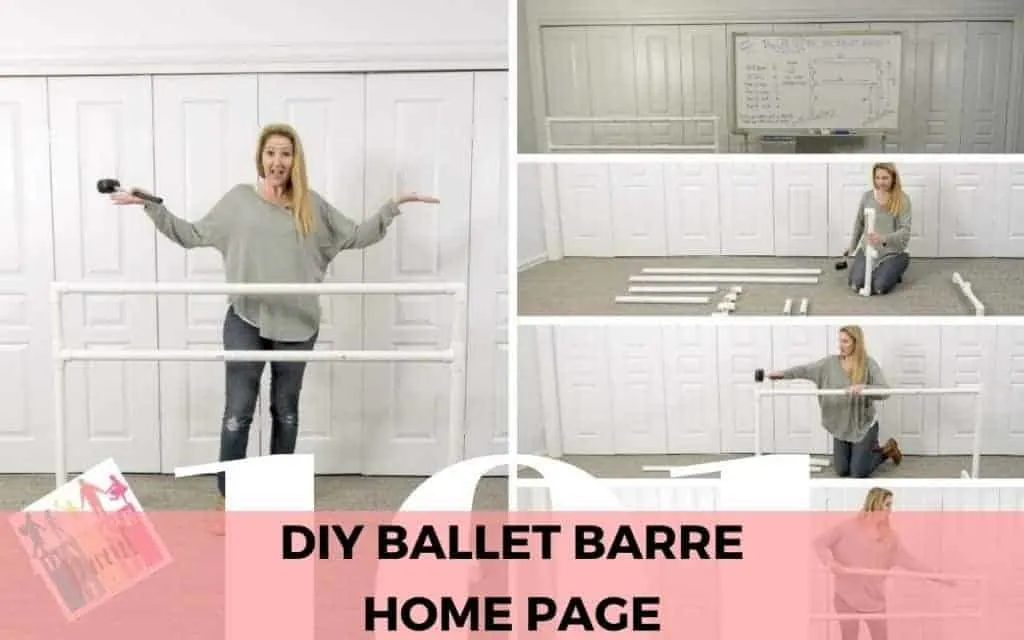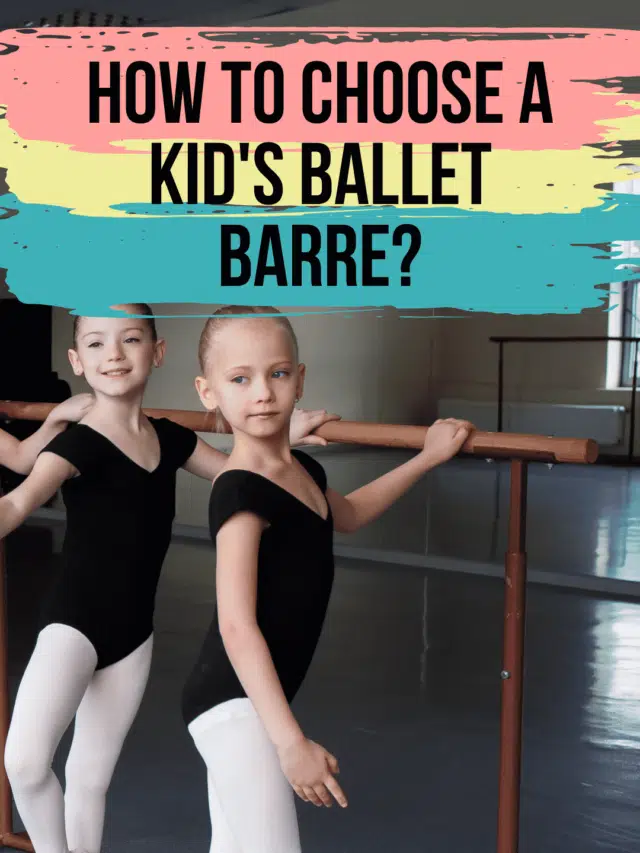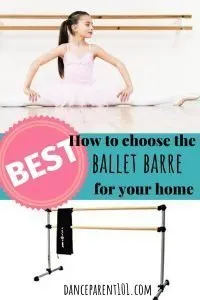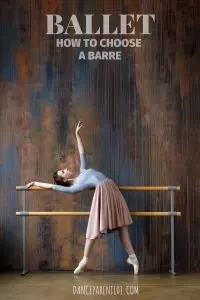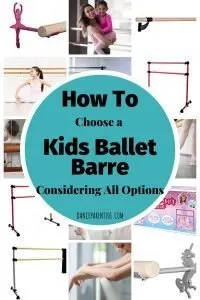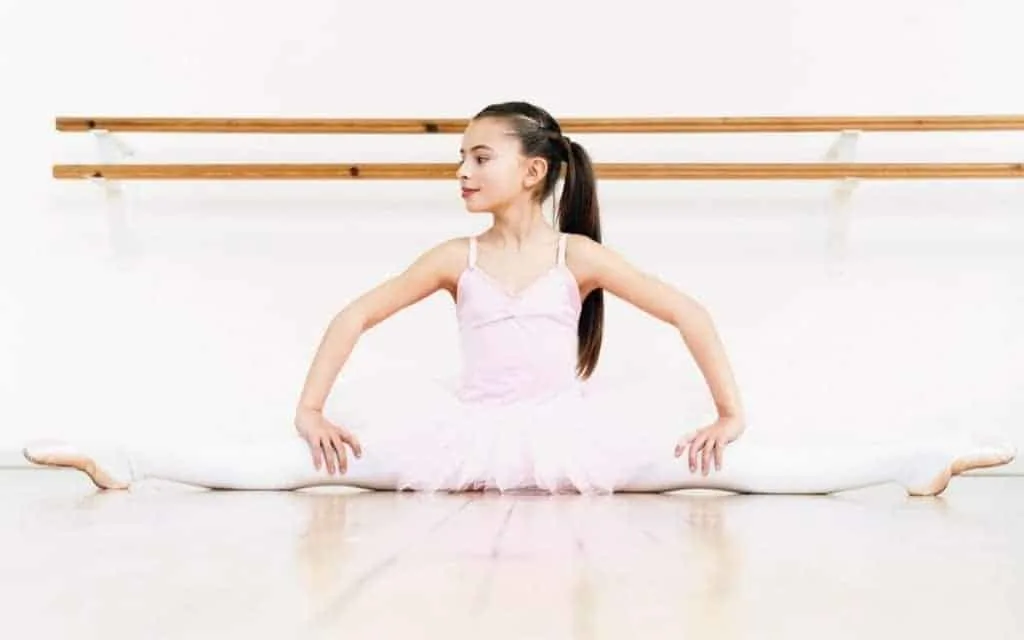
Buying a ballet barre for your child to use at home is a good way to give them more time to practice and hone their skills. But with so many of them on the market, it can be difficult to decide which one is the right choice for you.
I have two girls studying dance and ballet and so my personal recommendations are on a seperate page on the website which you can view here ballet barre resource page here.
In this article we will cover:
- The different materials barres are made from;
- The benefits of single and double barres;
- The difference between portable and wall-mounted barres;
- The perfect height for your barre, length and adjustability;
- Tips for making your own DIY ballet barre;
- The average cost of a ballet barre.
- Which is best – wood or metal?
There isn’t one be-all-end-all ballet bar that works for everyone. This is why we have created this guide to help you go through all the options to figure out what is most important to you and which bar fits those needs.
Please also note – this article uses affiliate linking to the ballet barres and other accessories sold by others. If you choose to purchase an item we receive a small commission at no extra cost to you but it does help us continue to provide you with helpful information here at Dance Parent 101.
WHAT IS A BALLET BARRE USED FOR?
A ballet barre is used by dancers to help them maintain their balance whilst warming up their muscles. Dancers gently place their hand on the barre to help them focus on developing their technique and strengthen targeted muscles rather than having to concentrate on being balanced. When a dancer is only concentrating on not falling they can activate muscles just being used to counter pull or push the wobbling or falling because the needed muscles are not yet strong enough to control them.
How Should A Ballet Barre Be Used?
A dancer should rarely put their full weight on the barre, aiming to gently and lightly touch the barre. But although this is how the barre should be used, dancers tend when they are learning and concentrating to grip the bar and exert a lot of weight on it so the barre needs to be sturdy enough to hold the dancer’s weight. It’s also common to see young kids hanging off them, so they need to be strong!
A ballet barre is also not only used in ballet lessons. During a tap lesson the teacher may ask students to rest their hand on the barre so they can concentrate on their footwork. In some cases, they may place their full weight on the barre to help elevate them when learning wings and other more technical steps that are done whilst also jumping or hopping.
Choosing a Kids’ Ballet Barre
Whether your child goes to a ballet studio or does tap lessons, having the option to practice at home is a fantastic way to further support them. Not everyone can have a fully dedicated room for dance practice in their home, but that doesn’t mean you can’t have a ballet barre handy.
When it comes to choosing the perfect ballet barre for your needs, there is quite a bit to consider. Ballet barres are all made differently, and every detail should be investigated to ensure you are getting the most for what you pay.
There are some decisions to make, based on the type of bar you want.
Materials
- Wood – Hardwoods such as ash, oak, maple, or poplar
- Metal – Such as steel or aluminum
- Plastic – Typically PVC pipe
Configuration
- Single Barre – Only one bar running from end to end
- Double or even triple barre – Two or three bars of different heights, one above the other
- Adjustable – can the barre be moved up and down for height variances?
Types of Bar
- Fixed Ballet Bar – A bar mounted to the wall or floor
- Portable Ballet Bar – A freestanding bar that runs between two portable supports
Along with these options, you should also take into consideration different things to narrow down your choices.
- How much space do you have to spare?
- Is adjustability important to you?
- How much are you willing to spend on a ballet bar?
While it may seem like a lot to take in, certain options will make more sense for you and your child. All you have to do is take a look at the benefits and drawbacks of each, and soon, the perfect choice for you will become clear.
Ballet Bar Materials
Ballet bars are all typically made from one of three materials– wood, metal, or plastic.
Deciding which material is best for your new ballet bar mostly comes down to your personal preference as well as your budget.
Each of these materials has its pros and cons that should be considered before purchase. Let’s take a closer look at all three of them to help you more easily decide which one will best suit your needs.
Wood
Wood is perhaps the most popular choice of material when it comes to a ballet bar. You will more than likely see wooden bars fixed to the wall of a dance studio, though it’s not quite as common when it comes to portable bars.
Pros
- A wooden ballet bar is an aesthetically pleasing choice that is beautiful to look at as well as handle.
- It is a relatively lightweight material that is stronger in construction than a plastic ballet bar.
- Wood isn’t cold to touch and when properly sanded and varnished or oiled feels comforting under the dancer’s hand.
- Wood is a renewable and recyclable resource.
Cons
- Wood can get a little pricey depending on the type of wood you’re looking for and how long you want your bar to be.
- When you get a bit lengthy, it’s more difficult to find quality pieces of wood that are long enough for a reasonable price.
- You can always opt for a cheaper type of wood, but you get what you pay for. Cheaper wood will split and splinter more easily over time.
- Portable Wooden ballet bars can loosen and fall from their metal sockets. Through constant moving and gripping the wood in a portable bar especially one that is consistently taken apart can move and fall out whilst in use and cause an injury.
Metal
Metal such as aluminum can be used in both fixed and portable bars for your child. Heavy steel or iron is more likely seen in a studio as a portable barre rather than a fixed one to the wall. Heavy metals are used for studio portable barres to make them extremely sturdy, whereas at home you might want to opt for something made out of a lighter metal such as aluminum so it can be moved easily. I have an aluminum one at home from Fulfit which you can read more about here.
Pros
- Depending on the metal used, these ballet bars can be relatively inexpensive as well as exceptionally sturdy.
- Aluminum is a popular choice of material. It is very lightweight and can be easily transported from place to place.
- Aluminium barres can be produced cheaply and the savings is transferred to you the customer.
- Keeping up portable metal bars is an easy task if you look after them.
Cons
- You may run into a weight issue if you decide on a metal such as steel. It would mean the need for more supports to make sure it is secure.
- Heavy metal portable barres need to be carried by two to three people and are best for dance studios rather than for homes.
- Aluminum ballet barres need to be powder-coated, as exposure to raw aluminum can turn your hands black.
- An aluminum bar can dent or bend if not looked after properly.
- Fittings can begin to come loose when moving the bar about and will need regular checking and tightening to prolong the life of your ballet bar.
- Metal is a conduit of heat and cold. Generally if in a studio or home the metal is cold to the dancer’s touch sometimes making it uncomfortable to use.
Plastic
A plastic ballet bar is made from PVC pipe, which is incredibly light and inexpensive. You can buy a plastic ballet barre – usually made as a for children to pretend dance with or make a DIY one as the materials used to make these ballet barres are easily accessible to anyone with a hardware store nearby.
Pros
- Plastic barres are great for anyone just starting out who have a tight budget.
- PVC pipe is great for making your own DIY barre which you can custom make to be the perfect height and length.
- PVC and Plastic pipe ballet barres are lightweight and easy to carry.
Cons
- The fittings and supports that come with a plastic ballet bar are not suitable for fixed bars. They just won’t last.
- These bars also have the shortest life expectancy of any of the materials. If you do not subject the bar too heavy training or too much pressure, it will last longer.
- The plastic barre can easily break if someone tried to for example sit on it.
- Not all plastic is recyclable and it takes many years to break down.
Single vs. Double Bar
You should decide before purchasing your child’s ballet bar if you would prefer a single bar or a double bar. You can find both configurations in both fixed and portable bars, depending on your needs.
Single Bar
A single ballet bar will cost you a little less than a double bar will. Single ballet bars are simply one bar attached to the wall or fixed between two portable supports that hold it above the floor. Double ballet bars are comprised of an upper and lower bar.
Double Bar
While single bars may be more cost-effective, double bars offer more versatility. They are especially useful if you have more than one child that will be using the ballet bar where each child requires a different height. A double bar will prevent you from having to adjust the height constantly.
Double bars also make it more efficient to do different stretches and exercising without adjusting the height of the bar. The two different heights give your child a lot more options when it comes to practice than with a single bar.
Fixed Ballet Barre
A fixed ballet barre is one that is permanently mounted to the wall or floor of your home or dance studio. These bars are most often found in studios that are used primarily for dance. You will more than likely find them made from wood. A fixed ballet bar will cost you anywhere from $100 to $400. For some sturdier options rather than these decorative ones, check out my ballet barre recommendations on the resource page here.
Pros:
- Incredibly Supportive
- Long-Lasting
- Always accessible
Cons:
- Must Stay in One Place
- Only One Height
Fixed ballet bars are a stronger option when it comes to ballet barres. When properly fixed to the wall, they are mounted permanently in position, and there is little chance of it falling off or over like a portable bar. Because of its sturdiness, a fixed bar may provide better balance to your young ballerina as they practice.
Having a ballet barre permanently mounted to the wall or floor isn’t ideal for all rooms in a regular house. For this reason, when you are buying a ballet barre for your home, a fixed bar isn’t always the best option. While you can take them down and put them up again for practice, that isn’t their intended use and would deteriorate the wall fixing and holes making it less and less sturdy over time.
Fixed ballet bars also come with the added disadvantage of staying at one height. Anyone with kids knows how quickly they grow. A ballet bar is an investment and having one that is fixed in one position could end up as a nuisance to some people who don’t want to have to unmount and remount it whenever your child grows taller.
If you have a dedicated ballet studio or practice area somewhere in your home, a fixed ballet bar may be a wonderful choice for your child. A double ballet bar is the most versatile but a little more expensive and will provide a long lifetime of support for your ballerina.
Portable Ballet Barre
For home use, a portable ballet barre can be convenient and a space saver. They are made for ease of use and storage so that you don’t have to worry about constantly tripping over your child’s equipment when they aren’t using it. A portable ballet bar will cost you anywhere from $100 to $350.
Pros:
- Portable
- Easily Stored
- Adjustable Height
- Double-Sided Use
Cons:
- Not as Supportive
- May not Last as Long from being moved constantly and because products used to make them need to be light enough to move and therefore are more fragile.
The biggest perk of a portable ballet barre is in the name itself—portability. These ballet barres are made so that you can easily pick them up and move them around your house. You don’t have to worry about always having a certain space free. Many of them also come with carrying cases for ease of transport. Match a portable ballet barre with a Dot 2 Dance, a lightweight portable circular piece of Marley dance flooring and you have an instant home studio for the dancer!
Portable ballet bars are also made with storage in mind. Some of them have feet that swivel so that they can be placed flat against a wall when not in use. Others fold all the way up so they can easily be fit inside a carrying case or other small space. They can even be taken along in the smallest of cars.
Because of their freestanding construction, portable ballet bars may not offer as much structural support for your child. However, this is a small issue, as they are still rather sturdy in the way they are made and you are not supposed to grip the barre but gently rest your hand on it for support. Some argue that this design is better for learning ballet, as your child is less likely to rely as much on the support while practicing.
Any portable ballet barre you find will most likely have the added benefit of being adjustable in height. This is a wonderful option for a growing child that may need it to be taller later down the line. A portable double bar may even have the option of adjusting the height of each bar independently from the other.
Another small perk to owning a portable ballet bar is the fact that both sides of it can be used to practice. This allows for more children to use the bar at once if you have more than one or two. It means you can have a shorter bar and still have enough room for everyone to join in.
How Thick Should a Ballet Barre Be?
No matter the material your ballet barre is made from, it should only be a certain thickness to allow for a comfortable grip. The recommended thickness for a ballet bar is between 1- 2 inches in diameter. This is generally a good option for both kids and adults alike.
How Tall Should a Ballet Barre Be?
A ballet barre should be between 38″ and 42″ from When you are buying or making a Ballet Barre for the home you can individualize the height of the barre specifically for your child.
- For the best measurement specific to your child, find the point between your child’s elbow when their arm is resting by their side and where their hand is in the second position whilst on a flat foot. This will give you the best accurate positioning for the height of your bar. You should do this with their dance teacher to ensure they are holding their hands correctly in second.
- Alternatively, you will find the perfect height for the ballet barre will fall about waist height. This is a common marker for measurement people will go by and is perfectly adequate for your child.
Although setting the height of the barre in relation to your child’s height is a fantastic option that you have by installing a barre in your home, you might be wondering at what the most common height ballet barres are installed at in most dance studios.
The Royal Academy of Dance in their Exam Specification Documents write that the preferred barre height for two barres is approximately 102cm and 115cm or 40.2″ and 45.3″.
Having a freestanding ballet bar that is adjustable in height is the best option when it comes to buying one for your child. Children tend to grow rather quickly, and it’s easier to keep up with them when you can change the height of your ballet bar without a fuss.
How Long Should a Ballet Barre Be?
The length of your ballet bar really depends on how many people are using it and how much room you can spare.
- A ballet bar for the home should be at least 4 to 5 feet or 1.5m long. The longer the barre, the more support it will need. Longer bars are better suited for mounting so that you can add more brackets and supports into the wall studs or masonry where they are necessary.
Tips For Making Your Own DIY Ballet Barre
If you are more inclined to do things yourself, you can always take up the challenge of building your own ballet bar for your child. This will take a little more effort but will also cost you less in the long run for the materials. I took on the challenge of making a DIY ballet barre, and then went on to make 9 different barres to find out one we liked best! If you are interested in making your own barre be sure to check out the following:
- Making a fixed ballet bar will be an easier task than making a portable one. This is because a fixed ballet bar is only comprised of the bar itself and the brackets and fixings that mount it to the wall.
- Consult someone at your local hardware store as they will have the knowledge of the best kind of brackets to use. Always employ a level when measuring where to put your brackets to ensure your bar isn’t crooked before mounting.
- If you decide to make your own portable ballet bar, you might lose some of the benefits of buying a professionally crafted one. Most tutorials you will find are for barres at a fixed height rather than being adjustable.
- If you are not skilled in DIY consider purchasing a wall-mountable kit or a pre-made portable ballet barre. This is because when you work out how much you will end up paying for the materials and tools you need and also take into account the time it will take you to research, measure, cut the materials and assemble them it might work out cheaper than making one yourself.
- Having said that, I have done most of the hard work with measurements, material lists, and more when I made and tested 9 different DIY ballet barres so make sure you check out the DIY ballet barre section on this website where I have videos teaching you exactly how to build one yourself!
Building your own ballet barre might also mean it won’t be one that can be folded up, which takes away some of the storage capabilities. The feet can usually swing to the side and they can still be picked up and moved out of the way whenever they are not in use.
WHICH IS BEST A WOOD OR METAL BARRE?
Deciding on whether to buy a wood or metal barre really comes down to personal preference. Some people like myself like the traditional feel and look of a wooden barre whilst others like the durability of a metal barre. You can see which ballet barre I recommend on our resource page here. Powdered Aluminium can come with anti-microbial qualities which can make it harder for germs to thrive from being touched by different hands. It can also be wiped clean easily. Wood needs to be sanded and oiled or varnished to keep it in top shape and overtime the powder coating on aluminum can chip so they both have their pros and cons. Aluminum is generally lighter than wood when used in a portable bar so this might be a selling point for metal over wood in this situation.
There’s a Ballet Barre for Every Child!
Buying something so important for your budding dancer is a big decision as you don’t really want to have to buy a second one when they grow. There are a lot of options out there to choose from, and you want to make sure you pick the best one for your child.
When you are trying to find the perfect ballet barre for your child, it’s important to keep in mind your own needs in your home. Where and how you live will most likely determine what type and size of the ballet barre you ultimately purchase or build. The material it’s made from will hinge more on your budget and your personal preference.
No matter what ballet bar you decide to get your child, they will benefit from the added practice space at home. There are so many amazing options for your home that you should undoubtedly be able to find exactly what you are looking for, no matter what your needs.
Want to see which ballet barre I am going to buy for my girls soon? You can check out my top recommendation on this resource page!
Share this article on Pinterest Now!
